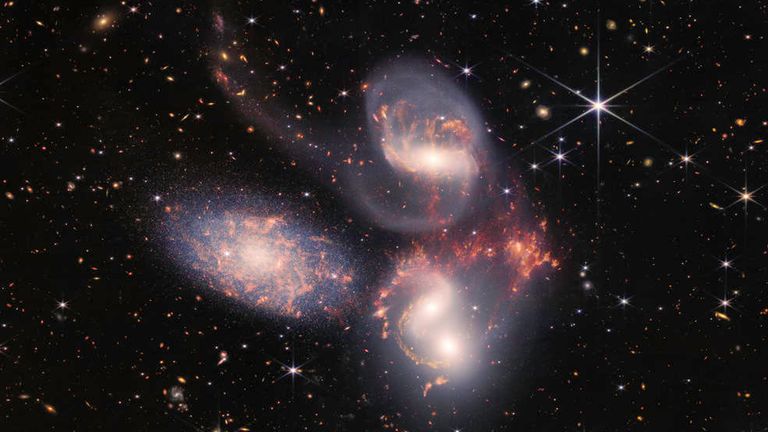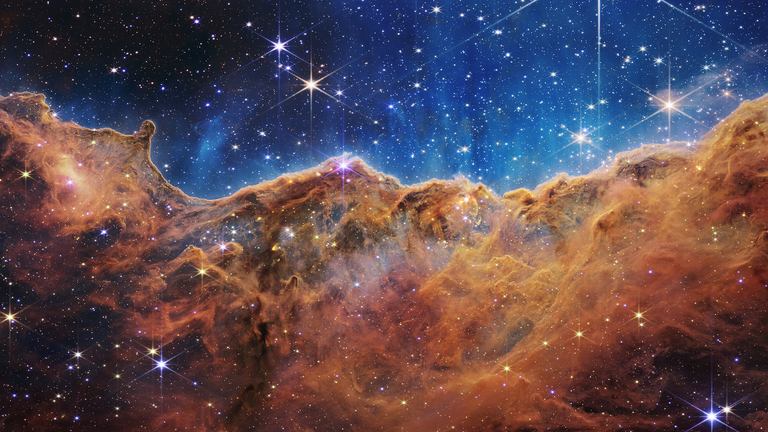A dying star and a ‘cosmic dance’: Ancient galaxies revealed in never-seen-before telescope pictures | Science & Tech News

A brand new, detailed view of the universe that looks further back into space and time than ever before has been revealed in an extraordinary set of photos.
NASA has released a full set of images from its James Webb Space Telescope, showing what is said to be the “deepest” and most detailed picture of the cosmos to date.
This new view of the universe is possible because the Webb is huge – with a mirror more than twice the size of the previously-used Hubble.
It is the largest and most powerful telescope ever sent into space.
NASA Administrator Bill Nelson said: “Every image is a new discovery and each will give humanity a view of the humanity that we’ve never seen before.”
The first image: cluster of distant galaxies
The image above shows a deep field cluster of distant galaxies, as they looked billions of years ago.
Jane Rigby, who worked on the project, says this shows them from about the time the sun and earth formed.
The image has a “sharpness and clarity” we’ve never had before, she says, and under a close-up, it is possible to see “individual clusters of stars forming, just popping up like popcorn”.
Although if it looks a bit familiar, it’s because it was first revealed by NASA as a teaser yesterday.
Sky’s science and technology editor Tom Clarke says this is a long exposure photo of a tiny patch of the universe.
“If you held out your arm outstretched with a grain of sand on your finger- that’s the size of the patch of sky this image covers,” he says.
The second image: a giant planet

This image is an analysis of the atmosphere of a giant planet called WASP-96 b, and is the first “spectrum analysis” of an exoplanet’s atmosphere.
Webb will take a number of “spectrum” photos in the coming months.
This process involves spitting light into its component “colours” in order to show what a body is made of, how fast it is moving, or even what its temperature is.
This analysis is of a giant gas planet located nearly 1,150 light-years from Earth, which orbits its star every 3.4 days.
It has about half the mass of Jupiter, and its discovery was announced in 2014.
NASA said: “Webb spotted the unambiguous signature of water, indications of haze & evidence for clouds (once thought not to exist there)!”
The third image: a planetary nebula

In this infrared image, we can see a planetary nebula caused by a dying star.
It is nearly half a light-year in diameter and is located approximately 2,000 light-years away from Earth. A light-year is 5.8 trillion miles.
The star can be seen expelling a large fraction of its mass.
The Southern Ring Nebula, is sometimes also called “eight-burst”.
The fourth image: Stephan’s Quintet

This image is of a group of five galaxies, two of which are in the process of merging.
It’s a combination of mid-infrared and near-infrared images that reveals stars being born.
Although called a “quintet” only four of the galaxies are truly interacting in a cosmic dance – the one on the left is actually in the foreground.
The fifth image: cosmic cliffs of the Carina Nebula

This stunning image shows us – for the first time – hundreds of stars that were previously completely hidden from our view.
The Carina Nebula is a nearby (in space terms) star-forming region within our own Milky Way galaxy.
The “cosmic cliffs” were previously pictured by Hubble’s telescope, but this new view gives us a rare glimpse of stars in their earliest, rapid stages of formation.
The near-infrared shows hundreds of stars and background galaxies, while the mid-infrared shows dusty planet-forming disks (in red and pink) around young stars.
Telescope’s mission
A partnership of scientists and engineers was formed between NASA, the European Space Agency and the Canadian Space Agency – and for 20 years they worked to complete the £8.4bn telescope.

US President Joe Biden got a sneak-peek of the images yesterday
Read more: Analysis: Why are these pictures such a big deal?
The deepest view of the universe ever captured: NASA releases first image from new space telescope
On Christmas Day, 2021, the Webb was launched and it reached its destination in solar orbit nearly 1 million miles from Earth a month later.
Once there, the telescope underwent a months-long process to unfurl all of its components, including a sun shield the size of a tennis court, and to align its mirrors and calibrate its instruments.
The universe has been expanding for 13.8 billion years, meaning the light from the first stars and galaxies has been “stretched” from shorter visible wavelengths to longer infrared ones.
This is what allows Webb to see the universe in unprecedented new detail.
These pictures are the first of millions the new telescope will produce over its 20-year lifetime.
Each full-colour, high-resolution picture that was unveiled on Tuesday took weeks to render from raw telescope data.
Watch-parties for the picture release took place all over the world including in the US, Canada, Israel, UK and Europe.
Recent Posts
- Agent Diary: Success isn’t just about opening loads of shops or racking up awards
- Polisi dan TNI Uji Coba Makan Bergizi Gratis di Bandung
- 2024 GBTA WINiT Summit and Gala Illuminates Women Professionals in the Business Travel Industry, Unveils New WINiT Path to Parity Initiative to Reach 50/50 Gender Equality by 2035
- How parents and teenagers can tackle ‘sextortion’ as online predator jailed | Science, Climate & Tech News
- Tampil Tanpa Yovie, Kahitna: Cuma Tuhan dan Presiden yang Bisa Memisahkan Kita
Recent Comments